Ke Yu
Rethinking Text-based Protein Understanding: Retrieval or LLM?
May 26, 2025Abstract:In recent years, protein-text models have gained significant attention for their potential in protein generation and understanding. Current approaches focus on integrating protein-related knowledge into large language models through continued pretraining and multi-modal alignment, enabling simultaneous comprehension of textual descriptions and protein sequences. Through a thorough analysis of existing model architectures and text-based protein understanding benchmarks, we identify significant data leakage issues present in current benchmarks. Moreover, conventional metrics derived from natural language processing fail to accurately assess the model's performance in this domain. To address these limitations, we reorganize existing datasets and introduce a novel evaluation framework based on biological entities. Motivated by our observation, we propose a retrieval-enhanced method, which significantly outperforms fine-tuned LLMs for protein-to-text generation and shows accuracy and efficiency in training-free scenarios. Our code and data can be seen at https://github.com/IDEA-XL/RAPM.
Learning and Current Prediction of PMSM Drive via Differential Neural Networks
Dec 12, 2024Abstract:Learning models for dynamical systems in continuous time is significant for understanding complex phenomena and making accurate predictions. This study presents a novel approach utilizing differential neural networks (DNNs) to model nonlinear systems, specifically permanent magnet synchronous motors (PMSMs), and to predict their current trajectories. The efficacy of our approach is validated through experiments conducted under various load disturbances and no-load conditions. The results demonstrate that our method effectively and accurately reconstructs the original systems, showcasing strong short-term and long-term prediction capabilities and robustness. This study provides valuable insights into learning the inherent dynamics of complex dynamical data and holds potential for further applications in fields such as weather forecasting, robotics, and collective behavior analysis.
ICODE: Modeling Dynamical Systems with Extrinsic Input Information
Nov 21, 2024



Abstract:Learning models of dynamical systems with external inputs, that may be, for example, nonsmooth or piecewise, is crucial for studying complex phenomena and predicting future state evolution, which is essential for applications such as safety guarantees and decision-making. In this work, we introduce \emph{Input Concomitant Neural ODEs (ICODEs)}, which incorporate precise real-time input information into the learning process of the models, rather than treating the inputs as hidden parameters to be learned. The sufficient conditions to ensure the model's contraction property are provided to guarantee that system trajectories of the trained model converge to a fixed point, regardless of initial conditions across different training processes. We validate our method through experiments on several representative real dynamics: Single-link robot, DC-to-DC converter, motion dynamics of a rigid body, Rabinovich-Fabrikant equation, Glycolytic-glycogenolytic pathway model, and heat conduction equation. The experimental results demonstrate that our proposed ICODEs efficiently learn the ground truth systems, achieving superior prediction performance under both typical and atypical inputs. This work offers a valuable class of neural ODE models for understanding physical systems with explicit external input information, with potential promising applications in fields such as physics and robotics.
NODE-Adapter: Neural Ordinary Differential Equations for Better Vision-Language Reasoning
Jul 11, 2024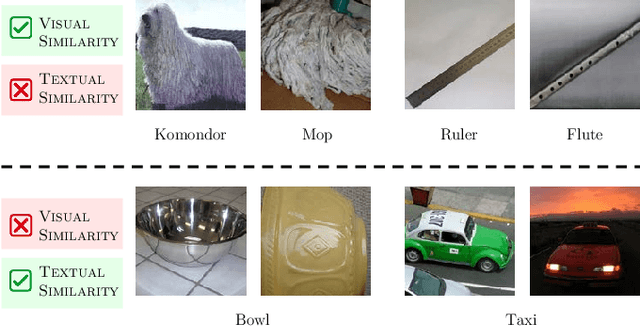
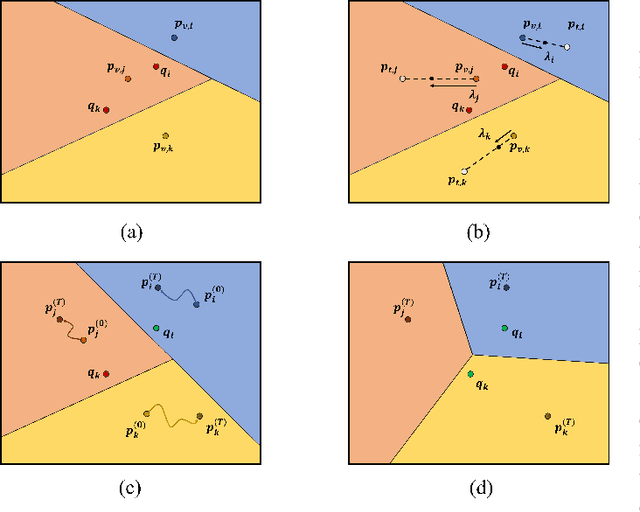
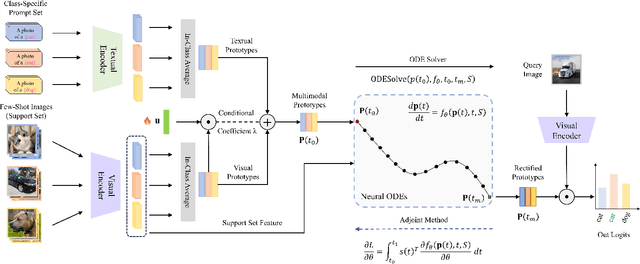
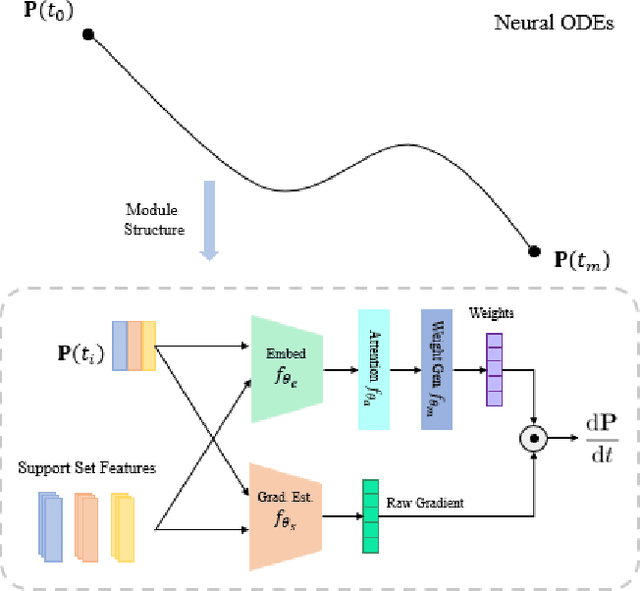
Abstract:In this paper, we consider the problem of prototype-based vision-language reasoning problem. We observe that existing methods encounter three major challenges: 1) escalating resource demands and prolonging training times, 2) contending with excessive learnable parameters, and 3) fine-tuning based only on a single modality. These challenges will hinder their capability to adapt Vision-Language Models (VLMs) to downstream tasks. Motivated by this critical observation, we propose a novel method called NODE-Adapter, which utilizes Neural Ordinary Differential Equations for better vision-language reasoning. To fully leverage both visual and textual modalities and estimate class prototypes more effectively and accurately, we divide our method into two stages: cross-modal prototype construction and cross-modal prototype optimization using neural ordinary differential equations. Specifically, we exploit VLM to encode hand-crafted prompts into textual features and few-shot support images into visual features. Then, we estimate the textual prototype and visual prototype by averaging the textual features and visual features, respectively, and adaptively combine the textual prototype and visual prototype to construct the cross-modal prototype. To alleviate the prototype bias, we then model the prototype optimization process as an initial value problem with Neural ODEs to estimate the continuous gradient flow. Our extensive experimental results, which cover few-shot classification, domain generalization, and visual reasoning on human-object interaction, demonstrate that the proposed method significantly outperforms existing state-of-the-art approaches.
Conceptual Codebook Learning for Vision-Language Models
Jul 02, 2024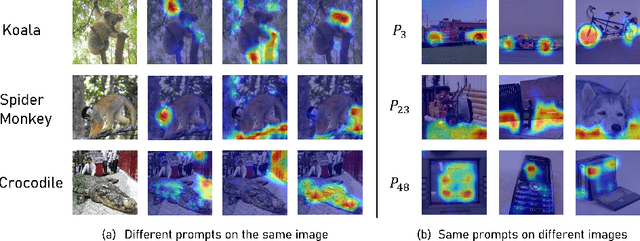
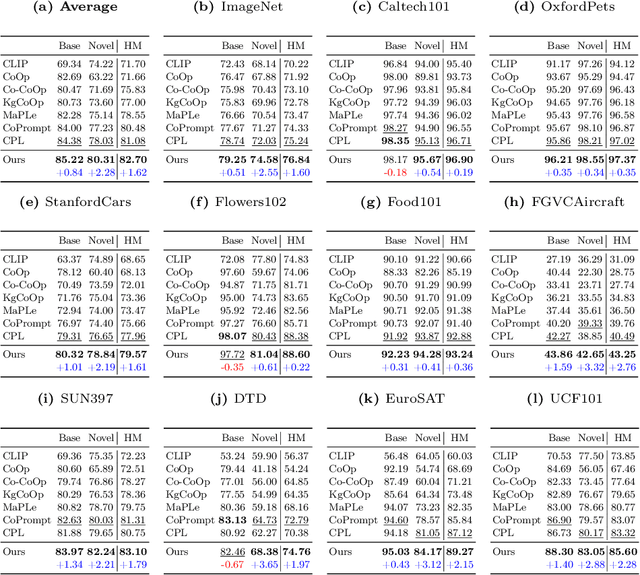
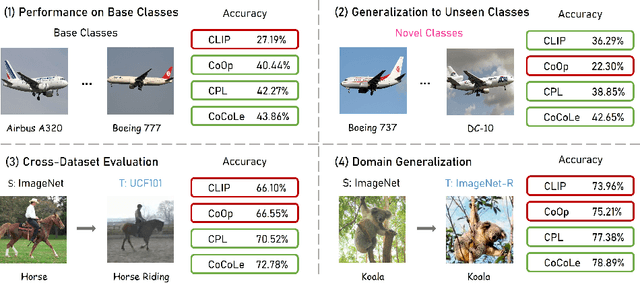
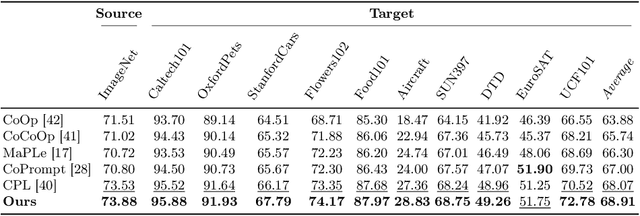
Abstract:In this paper, we propose Conceptual Codebook Learning (CoCoLe), a novel fine-tuning method for vision-language models (VLMs) to address the challenge of improving the generalization capability of VLMs while fine-tuning them on downstream tasks in a few-shot setting. We recognize that visual concepts, such as textures, shapes, and colors are naturally transferable across domains and play a crucial role in generalization tasks. Motivated by this interesting finding, we learn a conceptual codebook consisting of visual concepts as keys and conceptual prompts as values, which serves as a link between the image encoder's outputs and the text encoder's inputs. Specifically, for a given image, we leverage the codebook to identify the most relevant conceptual prompts associated with the class embeddings to perform the classification. Additionally, we incorporate a handcrafted concept cache as a regularization to alleviate the overfitting issues in low-shot scenarios. We observe that this conceptual codebook learning method is able to achieve enhanced alignment between visual and linguistic modalities. Extensive experimental results demonstrate that our CoCoLe method remarkably outperforms the existing state-of-the-art methods across various evaluation settings, including base-to-new generalization, cross-dataset evaluation, and domain generalization tasks. Detailed ablation studies further confirm the efficacy of each component in CoCoLe.
Concept-Guided Prompt Learning for Generalization in Vision-Language Models
Jan 15, 2024Abstract:Contrastive Language-Image Pretraining (CLIP) model has exhibited remarkable efficacy in establishing cross-modal connections between texts and images, yielding impressive performance across a broad spectrum of downstream applications through fine-tuning. However, for generalization tasks, the current fine-tuning methods for CLIP, such as CoOp and CoCoOp, demonstrate relatively low performance on some fine-grained datasets. We recognize the underlying reason is that these previous methods only projected global features into the prompt, neglecting the various visual concepts, such as colors, shapes, and sizes, which are naturally transferable across domains and play a crucial role in generalization tasks. To address this issue, in this work, we propose Concept-Guided Prompt Learning (CPL) for vision-language models. Specifically, we leverage the well-learned knowledge of CLIP to create a visual concept cache to enable concept-guided prompting. In order to refine the text features, we further develop a projector that transforms multi-level visual features into text features. We observe that this concept-guided prompt learning approach is able to achieve enhanced consistency between visual and linguistic modalities. Extensive experimental results demonstrate that our CPL method significantly improves generalization capabilities compared to the current state-of-the-art methods.
Learning to Adapt CLIP for Few-Shot Monocular Depth Estimation
Nov 02, 2023



Abstract:Pre-trained Vision-Language Models (VLMs), such as CLIP, have shown enhanced performance across a range of tasks that involve the integration of visual and linguistic modalities. When CLIP is used for depth estimation tasks, the patches, divided from the input images, can be combined with a series of semantic descriptions of the depth information to obtain similarity results. The coarse estimation of depth is then achieved by weighting and summing the depth values, called depth bins, corresponding to the predefined semantic descriptions. The zero-shot approach circumvents the computational and time-intensive nature of traditional fully-supervised depth estimation methods. However, this method, utilizing fixed depth bins, may not effectively generalize as images from different scenes may exhibit distinct depth distributions. To address this challenge, we propose a few-shot-based method which learns to adapt the VLMs for monocular depth estimation to balance training costs and generalization capabilities. Specifically, it assigns different depth bins for different scenes, which can be selected by the model during inference. Additionally, we incorporate learnable prompts to preprocess the input text to convert the easily human-understood text into easily model-understood vectors and further enhance the performance. With only one image per scene for training, our extensive experiment results on the NYU V2 and KITTI dataset demonstrate that our method outperforms the previous state-of-the-art method by up to 10.6\% in terms of MARE.
Two-Step Active Learning for Instance Segmentation with Uncertainty and Diversity Sampling
Sep 28, 2023


Abstract:Training high-quality instance segmentation models requires an abundance of labeled images with instance masks and classifications, which is often expensive to procure. Active learning addresses this challenge by striving for optimum performance with minimal labeling cost by selecting the most informative and representative images for labeling. Despite its potential, active learning has been less explored in instance segmentation compared to other tasks like image classification, which require less labeling. In this study, we propose a post-hoc active learning algorithm that integrates uncertainty-based sampling with diversity-based sampling. Our proposed algorithm is not only simple and easy to implement, but it also delivers superior performance on various datasets. Its practical application is demonstrated on a real-world overhead imagery dataset, where it increases the labeling efficiency fivefold.
Dividing and Conquering a BlackBox to a Mixture of Interpretable Models: Route, Interpret, Repeat
Jul 12, 2023Abstract:ML model design either starts with an interpretable model or a Blackbox and explains it post hoc. Blackbox models are flexible but difficult to explain, while interpretable models are inherently explainable. Yet, interpretable models require extensive ML knowledge and tend to be less flexible and underperforming than their Blackbox variants. This paper aims to blur the distinction between a post hoc explanation of a Blackbox and constructing interpretable models. Beginning with a Blackbox, we iteratively carve out a mixture of interpretable experts (MoIE) and a residual network. Each interpretable model specializes in a subset of samples and explains them using First Order Logic (FOL), providing basic reasoning on concepts from the Blackbox. We route the remaining samples through a flexible residual. We repeat the method on the residual network until all the interpretable models explain the desired proportion of data. Our extensive experiments show that our route, interpret, and repeat approach (1) identifies a diverse set of instance-specific concepts with high concept completeness via MoIE without compromising in performance, (2) identifies the relatively ``harder'' samples to explain via residuals, (3) outperforms the interpretable by-design models by significant margins during test-time interventions, and (4) fixes the shortcut learned by the original Blackbox. The code for MoIE is publicly available at: \url{https://github.com/batmanlab/ICML-2023-Route-interpret-repeat}
* appeared as v5 of arXiv:2302.10289 which was replaced in error, which drifted into a different work, accepted in ICML 2023
Improving Text Matching in E-Commerce Search with A Rationalizable, Intervenable and Fast Entity-Based Relevance Model
Jul 01, 2023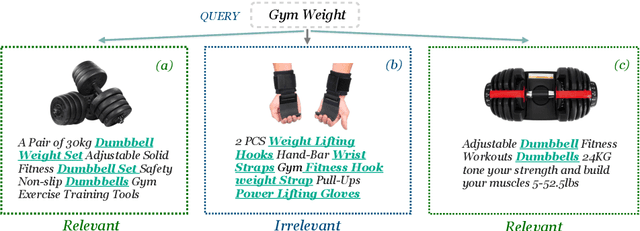
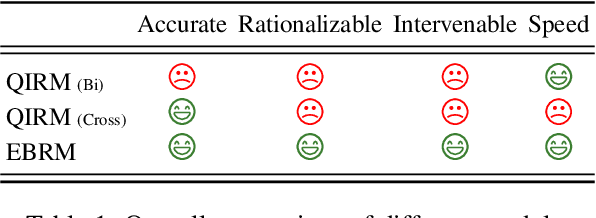
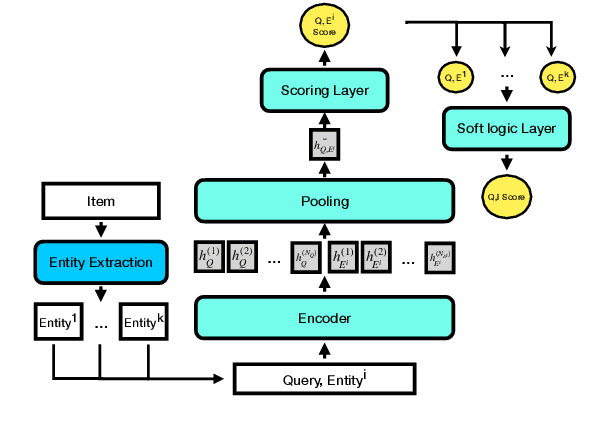
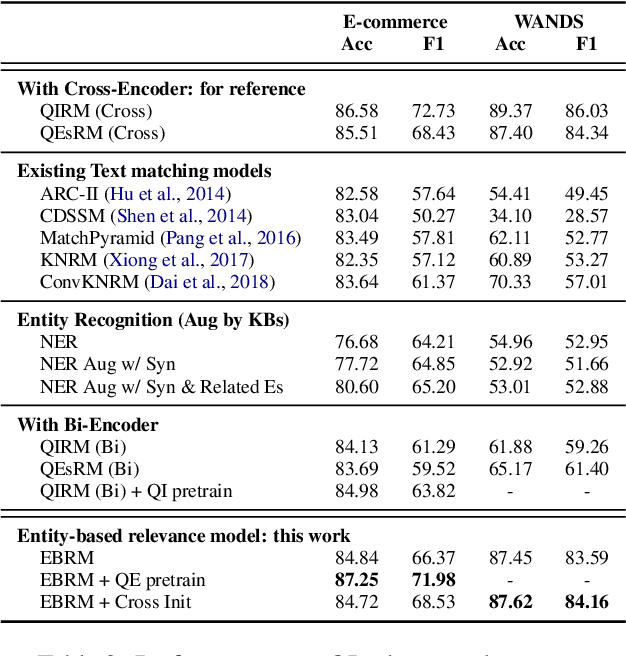
Abstract:Discovering the intended items of user queries from a massive repository of items is one of the main goals of an e-commerce search system. Relevance prediction is essential to the search system since it helps improve performance. When online serving a relevance model, the model is required to perform fast and accurate inference. Currently, the widely used models such as Bi-encoder and Cross-encoder have their limitations in accuracy or inference speed respectively. In this work, we propose a novel model called the Entity-Based Relevance Model (EBRM). We identify the entities contained in an item and decompose the QI (query-item) relevance problem into multiple QE (query-entity) relevance problems; we then aggregate their results to form the QI prediction using a soft logic formulation. The decomposition allows us to use a Cross-encoder QE relevance module for high accuracy as well as cache QE predictions for fast online inference. Utilizing soft logic makes the prediction procedure interpretable and intervenable. We also show that pretraining the QE module with auto-generated QE data from user logs can further improve the overall performance. The proposed method is evaluated on labeled data from e-commerce websites. Empirical results show that it achieves promising improvements with computation efficiency.
 Add to Chrome
Add to Chrome Add to Firefox
Add to Firefox Add to Edge
Add to Edge